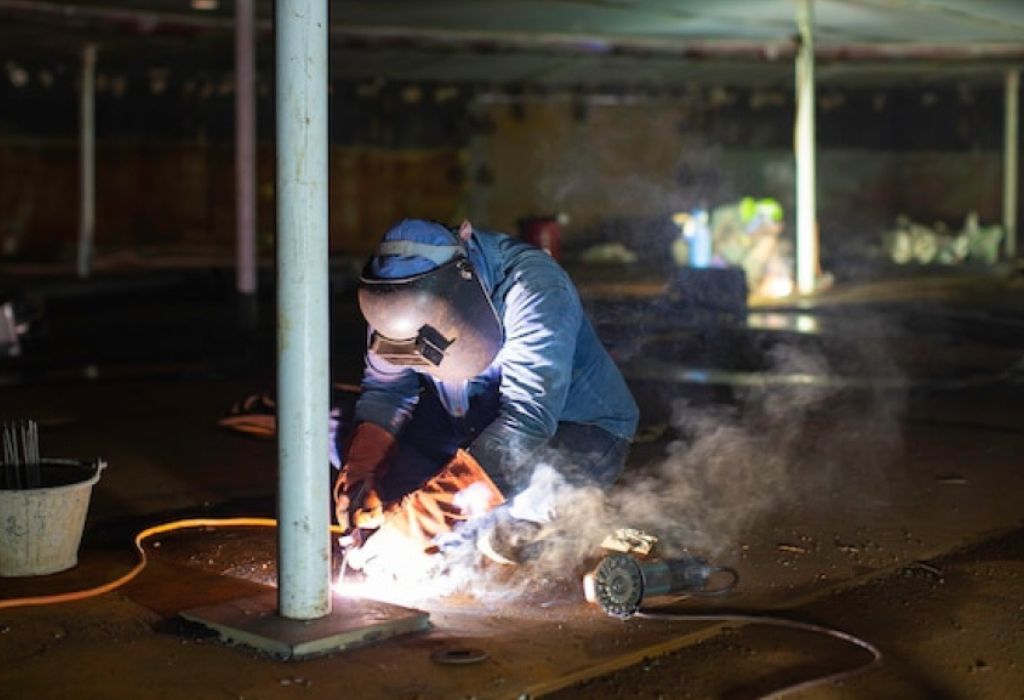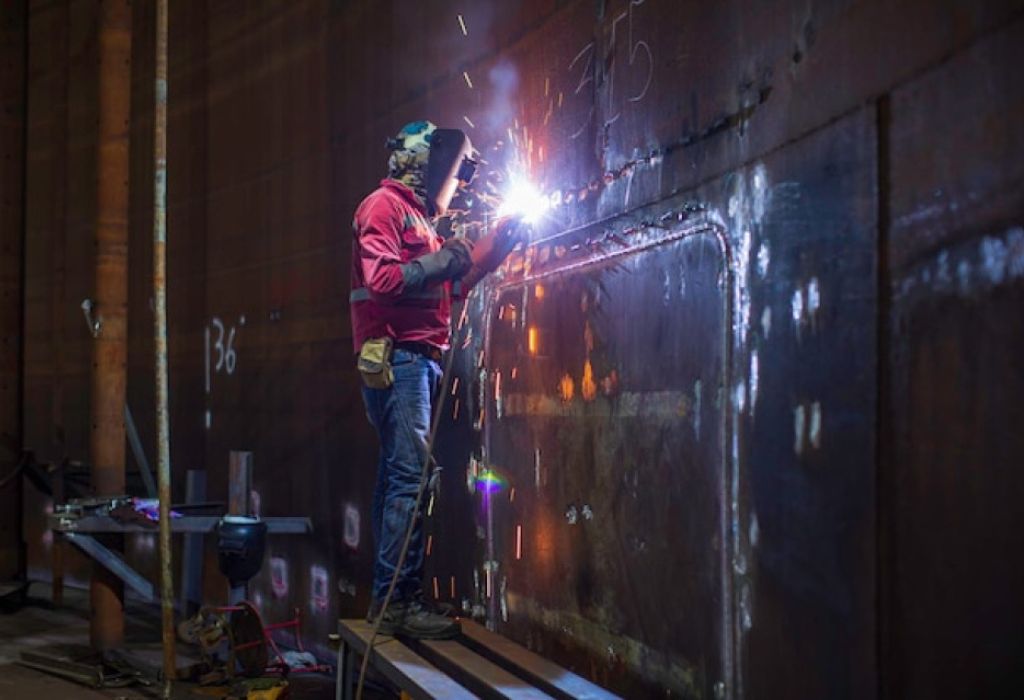A rookie stands on a steel beam as the skyline warms below, wondering whether the paycheck will match the risk.
The foreman mentions overtime, per diem, and union scale, and the question lands hard: how much does a structural welder make.
Official data gives a clear baseline. The Bureau of Labor Statistics reports a median annual wage around $52,640 for welders, with more than 421,000 employed nationwide, placing the trade among the largest skilled crafts in the country.
Job-market trackers show what structural welders actually see in offers and postings.
Averages hover near $24–$25 per hour, with ranges frequently stretching past $30 where demand, shift premiums, or per diems apply.
Company and sector matter. Glassdoor’s structural-welder estimates cluster near $60,600 per year, while shipyard roles often trend higher thanks to steady contracts and specialized procedures.
Location matters, too. Alaska and Bay Area metros routinely rank at the top of highest-paying lists due to travel requirements and cost of living pressures, while union locals publish scales that blend hourly rate, benefits, and retirement value.
This guide organizes the numbers and explains the levers that move them. The result is a straight answer and a roadmap to earning more without guesswork.
The Short Answer—Typical Structural Welder Pay Today

Structural welders earn competitive wages, but numbers vary depending on source and region. National job boards put the average in the mid-$20s per hour, with annual totals generally between $50,000 and $63,000.
ZipRecruiter lists an average near $24.39 per hour, while Indeed reports $25.24 per hour based on current job postings. Glassdoor estimates the average annual pay at $60,600, showing consistency across platforms.
Certain sectors and locations raise the baseline. Shipyard welders, for example, average close to $34 per hour, reflecting the complexity and demand of maritime fabrication.
These figures show why structural welding remains attractive to skilled tradespeople. The trade offers steady entry pay and clear pathways to higher income through overtime, specialty certifications, or relocation.
What’s the national average per hour?
Around $24–$25, depending on the platform.
What’s a typical annual salary?
Between $50,000 and $63,000 based on averages.
Do shipyards pay more?
Yes, with averages near $34 per hour.
How does this compare with all welders?
The BLS median for welders overall is about $52,640.
Is pay rising?
Yes, demand in infrastructure and shipbuilding pushes rates upward in many regions.
Salary vs Hourly—And Where Overtime Changes Everything
Most structural welders are paid hourly, making overtime a central factor in real income. Long shifts and compressed schedules can boost earnings far beyond the base wage.
Per diem allowances also play a role. Travel welders often receive housing or food stipends that increase take-home pay without raising taxable wages.
Shift differentials add smaller but consistent bumps. Night or weekend shifts often come with extra cents per hour that accumulate over a year.
Unionized crews typically have more predictable overtime rules. Collective bargaining agreements set boundaries for daily and weekly hours, ensuring fair pay for extra time.
How big is overtime’s impact?
Time-and-a-half can add thousands annually during peak projects.
Are per diems common?
Yes, especially for travel-heavy work.
What is a shift differential?
An added rate for nights, weekends, or holidays.
Union crews?
Overtime and shift rules are locked in contracts.
Do non-union welders still get OT?
Yes, but policies vary by employer.
National Data—What BLS Says About Welder Wages
The Bureau of Labor Statistics provides a broad view of welding as a whole. Structural welders fall within this group, mainly in construction and manufacturing.
The median annual wage for welders sits around $52,640, close to $25 per hour. The lowest 10% earn below $37,000, while the top 10% exceed $73,000.
Employment remains strong. Over 421,000 welders are employed in the U.S., with structural welding ranking as one of the more specialized branches.
These baseline numbers confirm that structural welding offers a solid foundation, even before overtime or bonuses are factored in.
Median welder wage?
About $52,640 annually.
Top 10% of welders?
They earn around $73,000+.
Employment size?
Roughly 421,000 welders nationally.
Is structural welding singled out?
Not in BLS data; it’s part of the broader category.
How useful is BLS data?
It provides a baseline for comparison with market numbers.
Real-Time Market—ZipRecruiter, Indeed, and Glassdoor
Online job platforms capture what employers are paying right now. ZipRecruiter, Indeed, and Glassdoor all list data that helps refine the national picture.
ZipRecruiter’s average is $24.39 per hour, while Indeed posts $25.24 per hour. Both align closely and reflect current openings.
Glassdoor offers a total pay estimate of $60,600 per year, with a typical range from $51,600 to $72,000 depending on bonuses and overtime.
Differences between sources come from sample sizes and industries. Some weight toward construction, others toward shipyards or fabrication shops.
ZipRecruiter hourly average?
About $24.39/hr.
Indeed hourly average?
About $25.24/hr.
Glassdoor annual pay?
Roughly $60,600.
Why do numbers vary?
Each site uses different data sources.
Which is most reliable?
Taken together, they validate a mid-$20s per hour norm.
Pay by State and City—Where Structural Welders Earn the Most
Geography matters. Coastal regions, high-cost metros, and remote areas often offer higher wages.
ZipRecruiter notes top-paying states include Alaska and California, where cost of living and demand drive wages above national averages.
Cities like San Francisco, Anchorage, and Seattle often show premium rates. Travel-heavy projects also bring per diem allowances on top of wages.
Union locals in these regions publish set scales that can be significantly higher than national averages.
Why do coastal states pay more?
Cost of living and travel premiums.
Is relocation worth it?
Yes, if per diem and overtime are strong.
Do union scales vary?
Yes, each local sets rates and benefits.
Any standout metros?
Anchorage and Bay Area cities often top lists.
Can pay differ by hundreds per week?
Yes, depending on region and contract.
Industry Matters—Construction, Fabrication, and Shipbuilding

The sector shapes pay. Construction crews, fabrication shops, and shipyards all need structural welders but pay differently.
Shipyards lead with averages around $34 per hour, reflecting specialized procedures and higher safety requirements.
Fabrication shops may pay less but offer steady hours and predictable environments. Construction and field erection jobs usually pay more due to conditions and travel.
Government contracts or prevailing-wage projects can set higher guaranteed pay scales.
Do shipyards pay more?
Yes, often near $34/hr.
Are fab shops lower?
Yes, but steadier schedules.
Why is field work higher?
Conditions and travel premiums.
What about government jobs?
Prevailing wage laws often raise rates.
Does industry choice matter?
Yes, it’s a major pay factor.
Experience & Credentials—From Entry Level to Lead Hand
Experience and certification drive structural welder pay higher.
Entry-level roles average in the low $20s per hour, while experienced journey-level welders climb toward the high $20s and $30s.
AWS D1.1 certification, blueprint reading, and multiple position qualifications increase pay opportunities. Foremen and lead welders earn the highest rates.
Entry-level pay?
Around the low $20s/hr.
How to move up?
Pass AWS D1.1 or other site-specific weld tests.
How long to journeyman?
Depends on hours and test results.
Do credentials boost pay?
Yes, they open higher-rate jobs.
Are leadership roles better paid?
Yes, foremen earn more for responsibility.
Union vs Non-Union—Scales, Benefits, and Security
Union locals negotiate pay rates, overtime rules, and benefits, often raising total compensation.
Union members typically see higher base wages and access to pensions, healthcare, and job security. Non-union shops may pay more per hour but offer fewer benefits.
Ironworker and welder CBAs show structured ladders with guaranteed raises.
Who earns more overall?
Union welders often do when benefits are included.
What about overtime rules?
Set by collective bargaining agreements.
Are dues worth it?
Yes, many welders value the benefits.
Do non-union roles ever pay more?
Sometimes per hour, but without strong benefits.
Does union mean more stability?
Often, with steadier project pipelines.
Travel, Rig, and Shutdown Work—When Rates Jump
Travel welding and shutdown projects can significantly raise pay.
These jobs offer per diem, overtime-heavy schedules, and sometimes day rates. Welders may work six 10-hour shifts weekly during outages or construction pushes.
Rig welders and shutdown specialists often test in at each site, ensuring only highly qualified welders enter.
Is travel pay common?
Yes, especially for remote sites.
How high can pay go?
Day rates can exceed typical hourly wages.
Are tests stricter?
Yes, site-specific procedures apply.
Downsides?
Unpredictable breaks between projects.
Worth it financially?
Often yes, but with lifestyle trade-offs.
Company Examples—What Employers Actually Pay
Employer matters as much as region.
Basden Steel, for example, lists structural welder averages near $57,800 annually.
Shipyards such as HII report pay near $29 per hour, with overtime and contracts adding more.
Different contracts, cost of living, and company scales explain the variance.
Why do rates differ?
Markets and contract types vary.
Do shipyards add bonuses?
Some do, especially for long projects.
Is relocation worth it?
Yes, for higher-paying employers.
Overtime guaranteed?
No, depends on workload.
Should you check company postings?
Yes, for accurate, current data.
Benefits Beyond the Check—Total Compensation
Pay is only part of the package. Benefits add long-term value.
Union roles often include pensions, 401(k)s, and health coverage. Some employers add tool allowances, PPE stipends, or relocation support.
Per diem payments on travel jobs stretch further when untaxed.
What’s a pension worth?
Often several dollars per hour in equivalent value.
Are tool allowances common?
Yes, many shops and crews offer them.
How to compare offers?
Convert benefits into hourly equivalents.
Is per diem taxable?
Often not, but check with a tax professional.
Do benefits close pay gaps?
Yes, especially when health and retirement are added.
Outlook and Demand—Where the Work Is Growing

Structural welders remain in demand, especially in infrastructure and shipbuilding.
BLS data confirms a steady employment base of over 421,000 welders nationwide. Demand grows during infrastructure investment cycles.
Automation affects repetitive welds, but structural welders with certifications remain essential.
Are welders in demand?
Yes, especially in construction and shipyards.
Will robots take jobs?
Automation shifts tasks but doesn’t replace structural welders.
Best sectors for stability?
Infrastructure and government contracts.
Should new welders enter now?
Yes, demand supports entry-level growth.
Will demand grow long-term?
Yes, as projects expand nationwide.
How to Earn More—Tactical Moves That Raise Pay
Strategic decisions make big differences.
Targeting high-pay states, adding certifications, and accepting night shifts all raise pay. AWS D1.1 and multi-process credentials open more doors.
Experienced welders can move into supervisory roles or take on rig/shutdown projects for higher day rates.
Which cert pays fastest?
AWS D1.1 structural welding.
Do multi-process skills help?
Yes, they expand opportunities.
Is night shift worth it?
Yes, for the premium rate.
Can foreman roles pay more?
Yes, for responsibility and management.
Best long-term move?
Stack credentials and target high-demand sectors.
Conclusion
So, how much does a structural welder make? On average, around $24–$25 per hour, or $50,000–$63,000 annually, with upside from overtime, travel pay, and union benefits.
Top earners push beyond $70,000, and shipyard or rig welders can exceed $34 per hour.
The key is strategy: choose sectors with premiums, secure certifications, and leverage overtime. With the right mix, structural welding offers both a solid foundation and a path to higher earnings.

I’m Darrell Julian, the founder, lead writer, and hands-on welding enthusiast behind ArcWeldingPro.com. With more than 15 years of real-world welding experience, I created this platform to share what I’ve learned in the field, in the shop, and in the heat of the arc.


